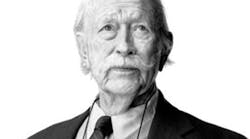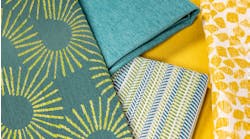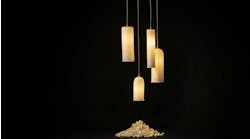The works of architect and designer Ralph Rapson (1914-2008) are emblematic of Midcentury Modern with their clean, geometric—yet minimalistic—silhouettes, and intelligent regard for space. Having studied at both the Cranbrook Academy and the New Bauhaus in Chicago where he would eventually teach, Rapson’s stunning drafts and drawings led him to work with the likes of Eero Sarinen, Charles Eames, Harry Bertoia, and Florence Schust, sketching whimsical and refined interiors.
In recent years, his work has reemerged. This summer, Leland International unveiled its Rapson Thirty-Nine collection, named after the year many of his sketches were dated. Working with the Cranbrook Academy and Rapson’s family, Leland has brought Rapson’s work to life.
Finding Rapson
“During Ralph Rapson’s life, he had an affinity to design furniture, as many architects do,” explained Bruce Sienkowski, 2B Studio, who manages product development and furniture design for Leland. “The first images were dated 1938 and 1939 from when he was at Cranbrook Academy. Ever since then, he did a good job of holding onto a lot of sketches he had conceived over the years.” Using the vast wealth of sketches from Cranbrook’s archives, Leland was able to pull out a number of drawings which could be produced into a unique collection. While many of the Cranbrook alumni have been lauded for what they created while at the academy, it’s Rapson’s architecture later in life that cemented his fame. Therefore, producing his earlier works was like unraveling a forgotten piece of history.
Working with the Family
Since his death in 2008, Rapson’s family has worked to keep his legacy alive. Aware of several marketing efforts by his estate for a handful of products already in production, Leland’s team reached out.
In the summer of 2015, Sienkowski met with Rapson’s son, Toby. From the sketches, they were able to pull out four different design vernaculars. “It was quite the range of products, so we chose those that we thought would have a lot of development over five or six years,” he said.
The Production Line
“It was a fairly smooth process,” Sienkowski admitted. “We’ve done everything we feel we can do to execute the designs in good faith, in some cases using better technology than they could in the past.” However, as some of the sketches were drawn two-dimensionally, the team had to come up with their interpretation of how the hidden portions would look. Once transferred to CAD models, Leland discussed with the family whether the working designs would hold up to Rapson’s aesthetic.
Further down the production process as designs were approved by the family and sent to be fabricated, they were again tweaked and reconsidered. “Materials were changed as we refined [the products]. For example, we moved to a 100 percent maple veneer. It was truer, we thought, to the form than what we had considered in the past.”
Maintaining Authenticity
One constant concern for designers and manufacturers is maintaining authenticity. Bringing historical artifacts such as Rapson’s work to life isn’t without concern for knock-offs flooding the market. The final touch not only added a personal touch, but ensured copycats would be deterred; each piece is marked with Rapson’s signature.
Continuing the Legacy
With a wealth of Rapson’s sketches and an enthusiastic response at NeoCon, Leland International will continue to release new works over the next few years. “It’s game changing for us,” said Shanna Anderson, Emerging Markets with Leland International. “There’s limited opportunity to design something like this, and the initial response was really overwhelmingly positive. One of the designers that came in said it was like discovering lost treasure.”
When asked about the future of the collection, Sienkowski added that it was possible for Leland to continue annual introductions for up to the next five years without stretching the authenticity of Rapson’s work. “The potential is quite broad because Ralph was quite conceptual.”



